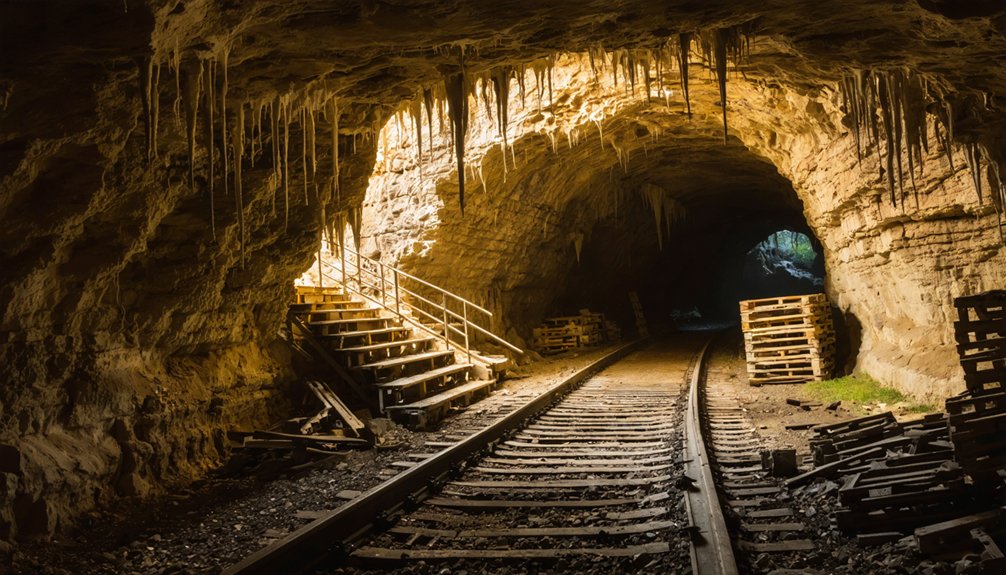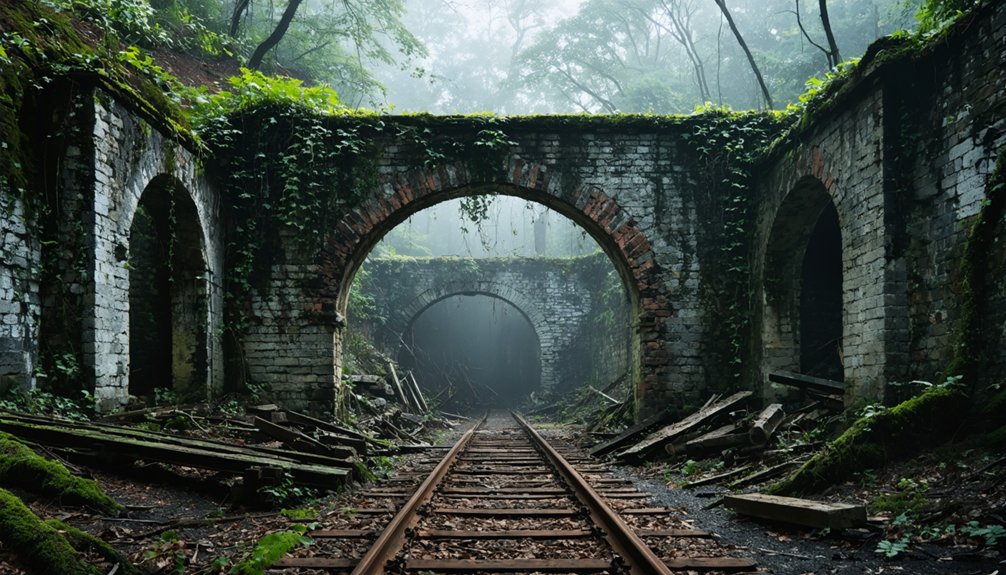You’ll find Kentucky’s abandoned Lawton Mushroom Mine deep in limestone country, where a thriving quarry operation transformed into a massive underground mushroom farm in the 1960s. The 2.6-million-square-foot tunnel network once produced 4 million pounds of mushrooms annually, maintaining perfect growing conditions at 55 degrees. Today, the mine stands empty, haunted by failed data center dreams, unsolved mysteries, and local legends of ghostly encounters within its dark passages.
Key Takeaways
- Lawton Limestone Company transformed its extensive 2.6-million-square-foot tunnel network into a successful mushroom farming operation after World War II.
- The mine’s natural temperature of 50-58°F and high humidity created perfect conditions for mushroom cultivation, producing 4 million pounds by 1972.
- A double homicide in 2004 involving Gary and Cheryl Young drew attention to the mine and contributed to local paranormal legends.
- Failed attempts to convert the mine into a data center in 2007 resulted in a fraud scandal, leaving abandoned structures and unpaid debts.
- The abandoned mine now features flooded tunnels, crumbling infrastructure, and attracts trespassers despite safety warnings from local authorities.
The Birth of Lawton Limestone Company
While Kentucky’s industrial landscape was rapidly evolving in the early 20th century, the Tygart Limestone Company emerged as a pioneering force in Lawton’s mining sector. The mine establishment marked a significant turning point for this small Kentucky town, as you’d discover a bustling operation focused on extracting valuable limestone and silica sands from the region’s rich geological deposits.
You’ll find that the company’s strategic location in Lawton proved ideal for limestone extraction, leading to the development of an extensive tunnel network that would eventually span an impressive 2.6 million feet.
The operation’s influence extended beyond mere industrial purposes, as it became the backbone of the local economy, providing jobs and stability to countless families who called this corner of Kentucky home. After World War II, the mine ceased operations and was transformed into a mushroom farming operation by local Kentucky farmers. The vast underground space created an ideal environment with its 70-million cubic feet of open chambers perfect for cultivation.
Underground Mining Operations and Methods
Three distinct mining methods shaped Lawton’s underground operations: drift, slope, and shaft mining. You’d find drift mines cutting horizontally into hillsides, while slope mines tunneled downward from valley floors. Shaft mining plunged vertically, sometimes reaching depths over 1,000 feet using elevator systems.
The primary mining technique you’d encounter was room and pillar extraction, where miners carved out coal while leaving support columns intact. Later, they’d introduce longwall mining, systematically removing large panels of coal while allowing controlled roof collapse behind them. Before strip mining became widespread, underground mining dominated throughout Ohio County’s coal fields. The abundant sandstone formations provided essential structural support for the mine tunnels and shafts.
After the 1940s, you’d see mechanical cutters and loaders revolutionizing these operations. Multiple entry points improved ventilation and transport efficiency, while on-site facilities like bathhouses and repair shops supported the underground workforce.
From Quarry to Mushroom Paradise
After decades of extracting limestone from Lawton’s underground chambers, the site’s destiny took an unexpected turn in the mid-1960s. Local Kentucky farmers discovered that the abandoned quarry‘s natural conditions were perfect for growing mushrooms.
This remarkable quarry transformation created a sustainable agricultural venture that would thrive for nearly twenty years. When operations eventually ceased in the early 1950s, discussions began about converting the space into a fallout shelter.
You’ll find the mine’s environment was ideal – maintaining steady temperatures between 50-58°F and 85% humidity year-round. These natural conditions eliminated the need for costly climate control systems.
The vast network of tunnels, spanning 2.6 million square feet across 136 acres, provided ample space for mushroom cultivation. Farmers used composted substrate from nearby horse tracks and poultry farms, while the existing rail lines and roads enabled efficient distribution of their harvest throughout the region. The operation proved highly successful, with production reaching 4 million pounds of mushrooms in 1972.
The Golden Age of Fungi Cultivation
You’ll find the abandoned Lawton mine‘s consistent 55-degree temperature and high humidity created ideal conditions for mushroom cultivation during the mid-twentieth century.
Controlled environments and specialized substrates revolutionized commercial mushroom growing during this era, allowing for year-round production.
The naturally occurring limestone caves provided perfect growing environments that local farmers quickly transformed into thriving mushroom operations, making Pennsylvania a dominant force in American mushroom production. Early growers used horse manure compost as their primary growing medium, following techniques developed in Paris.
Perfect Underground Growing Conditions
During the golden age of mushroom cultivation in Lawton’s underground quarries, growers discovered ideal natural conditions that revolutionized commercial fungi production.
You’ll find the limestone caverns provided perfect mushroom ecology, maintaining steady temperatures between 55-70°F year-round without expensive climate control systems. The natural underground agriculture setup offered consistent humidity levels similar to a forest floor, while the quarry’s existing ventilation shafts supplied essential air exchange for healthy mushroom development. Regular monitoring with pH testing equipment ensured optimal growing conditions were maintained.
These caves eliminated many challenges faced by above-ground operations – no need for complex lighting systems since mushrooms thrive in low-light environments, and the stable underground climate meant less energy spent on temperature regulation. The spawn to bulk technique was implemented perfectly in these conditions, with sterilized blocks colonizing efficiently in the cave environment.
Growers could focus on perfecting their substrate preparation and sterilization techniques, maximizing yields in this naturally optimized growing environment.
Regional Economic Agricultural Success
The underground quarries’ ideal growing conditions sparked a remarkable economic transformation in Kentucky’s agricultural landscape.
You’ll find that specialty mushroom sales skyrocketed from $65 million to $106 million between 2012 and 2018, as farmers embraced economic diversification through sustainable farming practices.
If you’d ventured into Letcher County or Lexington farmers markets during 2018, you’d have discovered premium shiitake mushrooms selling for up to $8 per quart.
Small-scale operations running 500 logs could earn net profits around $2,800 annually without hired labor.
Kentucky’s success joined states like Pennsylvania and California in the specialty mushroom boom, particularly with shiitake and oyster varieties.
This agricultural innovation created local jobs while making efficient use of forest resources, proving that fungi cultivation could revitalize rural economies.
Engineering Marvel: Inside the Mountain

Beneath the rugged terrain of Olive Hill, Kentucky, an engineering marvel stretches across an intricate network of chambers and tunnels, showcasing the remarkable design of post-World War II limestone mining.
The subterranean architecture features wide aisles and high-ceilinged chambers extending a quarter-mile from the entrance. You’ll find engineering innovations throughout, from the natural climate control system maintaining temperatures between 50-58°F to the sophisticated irrigation infrastructure added during its mushroom farming era.
The mine’s limestone composition provided ideal structural integrity, while its natural insulation eliminated the need for additional climate control systems.
Later engineering adaptations included plans for two-story buildings at tunnel entrances to support ambitious data center operations, though these never materialized due to project complications.
Dark Days: Crime and Mystery
Once a symbol of industrial prosperity, Lawton Mine’s legacy took a sinister turn when it became the scene of a shocking double homicide in 2004.
Gary and Cheryl Young’s bodies were discovered in the mine’s dark depths after their son, Andrew Young, confessed to authorities. The crime motives remained unclear, but complex family dynamics played a central role in this tragedy.
Andrew and his girlfriend, Stephanie Griffith, faced charges of murder and kidnapping, respectively.
- Bodies were found deep within the abandoned mine tunnels
- Andrew Young led police to his parents’ remains
- Investigation revealed signs of premeditated murder
- Family was well-known in the local community
- Crime shattered the area’s sense of security
Today, the mine’s haunting atmosphere draws curious explorers, despite trespassing warnings and safety concerns.
Local legends of paranormal activity have only added to its notorious reputation.
Failed Dreams of Digital Storage

If you’d visited Lawton Mushroom Mine in 2007, you’d have witnessed ambitious plans to transform the abandoned tunnels into a massive digital data storage facility, capitalizing on the mine’s naturally cool environment and vast underground space.
What began with promising construction and partial completion of support buildings quickly unraveled when investigators exposed the data center project as a fraudulent corporate scheme lacking legitimate funding.
Today, the half-finished structures stand as silent monuments to yet another failed attempt at repurposing this historic site, joining the mine’s long list of abandoned dreams.
Data Center Investment Plans
While Kentucky’s rural counties have attracted substantial interest from tech giants seeking to build massive data centers, the Lawton Mushroom Mine site’s own digital storage ambitions never materialized.
You’ll find a stark contrast between the mine’s failed plans and today’s multi-billion dollar investment proposals in Oldham and Mason counties, where companies are pushing to transform farmland into hyperscale facilities.
- Oldham County’s revised $1.5B data center plan requires 88 acres
- Mason County’s mysterious Fortune 100 company promises 400 permanent jobs
- Both projects would generate tens of millions in annual tax revenue
- Local communities resist the loss of rural character and farmland
- Infrastructure demands include massive power needs – up to 600MW
These modern proposals show how Kentucky’s landscape continues to attract bold technological ventures, even as earlier dreams fade into history.
Corporate Fraud Scheme Exposed
Behind the failed data center dreams at Lawton Mushroom Mine lies a tale of corporate deceit orchestrated by Global Data’s owner Liam P. Russell, a man with 36 felony counts in California for embezzlement and forgery.
His corporate negligence left a wake of unpaid local contractors and shattered promises in Kentucky.
You’ll find the evidence of financial irresponsibility in the numbers: over $232,000 owed to Woolpert Inc. for architectural services, $20,000 to McKenzie Concrete, and numerous other unpaid debts to local companies like Wells Ready Mix and Scioto Block.
When contractors stopped receiving payments in September 2006, the scheme unraveled.
Russell’s attempt to dodge responsibility through Chapter 13 bankruptcy failed, and the $1.2 million property sold for just $800,000 at auction, leaving the community to bear the cost of broken dreams.
Empty Buildings Stand Today
Today, the abandoned structures of Lawton’s former mushroom mine stand as silent monuments to unrealized digital ambitions.
You’ll find deteriorating buildings that once held promise as a cutting-edge data storage facility in the 2000s. The failed venture never materialized due to financial fraud, leaving the site’s natural cool temperatures and high humidity unused for modern purposes.
- Collapsing roofs and unstable floors threaten visitor safety
- Empty underground chambers echo with missed opportunities
- No climate control or power infrastructure was ever installed
- Graffiti marks walls where servers were meant to hum
- Decay spreads unchecked through unfinished upgrades
The decay threatens what remains of these structures, while tire tracks and explorer footprints mark the only current activity in a place that could’ve transformed regional tech infrastructure.
Instead, these halls stand empty, holding nothing but shadows and memories.
Architectural Legacy and Current State

Deep within Pennsylvania’s industrial heritage, the Lawton Mushroom Mine stands as a remarkable demonstration of architectural adaptability, featuring 2.6 million square feet of tunnels with soaring 27-foot ceilings and 32-foot-wide passages.
You’ll find multiple cave-like entrances carved into the mountainside, leading to an extensive network that showcases the site’s architectural significance in the region’s fire clay brick industry.
While the mine’s original limestone extraction purpose shifted to mushroom farming after WWII, you can now explore its abandoned chambers at your own risk.
Once a thriving limestone quarry turned mushroom farm, these haunting chambers now beckon adventurous souls to discover their secrets.
The site’s historical preservation remains neglected, with failed attempts to convert it into a data storage center leaving behind half-finished structures.
Today, nature slowly reclaims the space as water seeps through the tunnels, creating an underground lake within this deteriorating industrial monument.
Regional Economic Impact Through Time
Since its 1910 incorporation with $20,000 in capital, the Lawton Limestone Mine played a significant role in Pennsylvania’s industrial economy.
You’ll find its limestone supplied essential flux to Ashland Iron Works while supporting regional steel production and transportation infrastructure.
The site’s economic diversification showcases remarkable community resilience through three distinct phases:
- Initial limestone quarrying operations spanning 136 acres with 2.6 million square feet of tunnels
- Innovative shift to mushroom farming in the mid-1960s, sustaining local agribusiness jobs
- Attempted transformation into a digital data storage center in the early 2000s
- Development of specialized workforce skills across mining, agriculture, and tech sectors
- Contribution to regional cultural heritage tourism despite operational closure
Though now a ghost town, Lawton’s legacy demonstrates how rural communities can adapt to changing economic landscapes through creative infrastructure repurposing.
Local Legends and Ghost Stories
Countless ghost stories and local legends swirl around the abandoned Lawton Limestone Mine, drawing paranormal enthusiasts and urban explorers to its remote Pennsylvania location.
When you venture near the mine’s entrance, you’ll hear haunted whispers of ghostly miners still at work in the tunnels below, their phantom tools echoing through the darkness.
Local folklore tells of eerie encounters with an albino figure stalking the grounds, while others report Bigfoot sightings in the surrounding woods.
The mine’s history of failed ventures, from limestone extraction to mushroom farming, has only deepened its mystique.
You’ll find that the abandoned tunnels served as gathering spots for local teens and, more ominously, as sites for alleged occult rituals.
Despite warnings against trespassing, the mine’s reputation for paranormal activity continues to captivate those seeking supernatural thrills.
Frequently Asked Questions
What Safety Equipment Is Recommended for Exploring the Abandoned Mine Today?
You’ll need boots, hard hat, gloves, multiple lights with extra batteries, safety ropes, first-aid kit, protective clothing, communication devices, and navigation tools for safe gear and exploration tips.
Are Any of the Original Mining Tools Still Present in the Tunnels?
You’ll find very few mining artifacts since most equipment was removed after closure. The rare tools you might spot are badly deteriorated and shouldn’t be disturbed for historical preservation purposes.
How Many Workers Were Employed During Peak Limestone Production Years?
Even without Netflix to pass the time, you’d have seen dozens to possibly over 100 workers during peak production, though exact numbers aren’t documented. Worker conditions evolved until production decline after WWII.
What Specific Mushroom Varieties Were Cultivated in the Underground Farm?
You’ll find that white button mushrooms (Agaricus bisporus) were the main variety cultivated through underground farming at this site, though detailed records of other potential mushroom cultivation remain unclear.
Has Anyone Attempted to Purchase and Restore the Site Recently?
You won’t find any successful recent inquiries to buy the site. Since the failed data center scam in 2008, there haven’t been any legitimate restoration projects or documented purchase attempts.
References
- https://abandonedonline.net/location/tygart-limestone-company/
- https://thewanderingrver.com/tag/mushroom-mine/
- https://wkdq.com/are-ghosts-haunting-an-abandoned-mine-in-ky-see-the-pics/
- http://thecliosociety.blogspot.com/2014/02/the-mushroom-mines-of-kentucky.html
- https://www.youtube.com/watch?v=Gcbau01Tah4
- https://wbkr.com/ky-mushroom-mine/
- https://scholarworks.moreheadstate.edu/cgi/viewcontent.cgi?article=1170&context=kentucky_county_histories
- https://theravenbran.wordpress.com/2015/07/20/lawton-mushroom-limestone-mines-07182015/
- https://www.rockportky.com/CoalMines/CoalMining.html
- http://www.coaleducation.org/coalhistory/coaltowns/historic_context.htm



